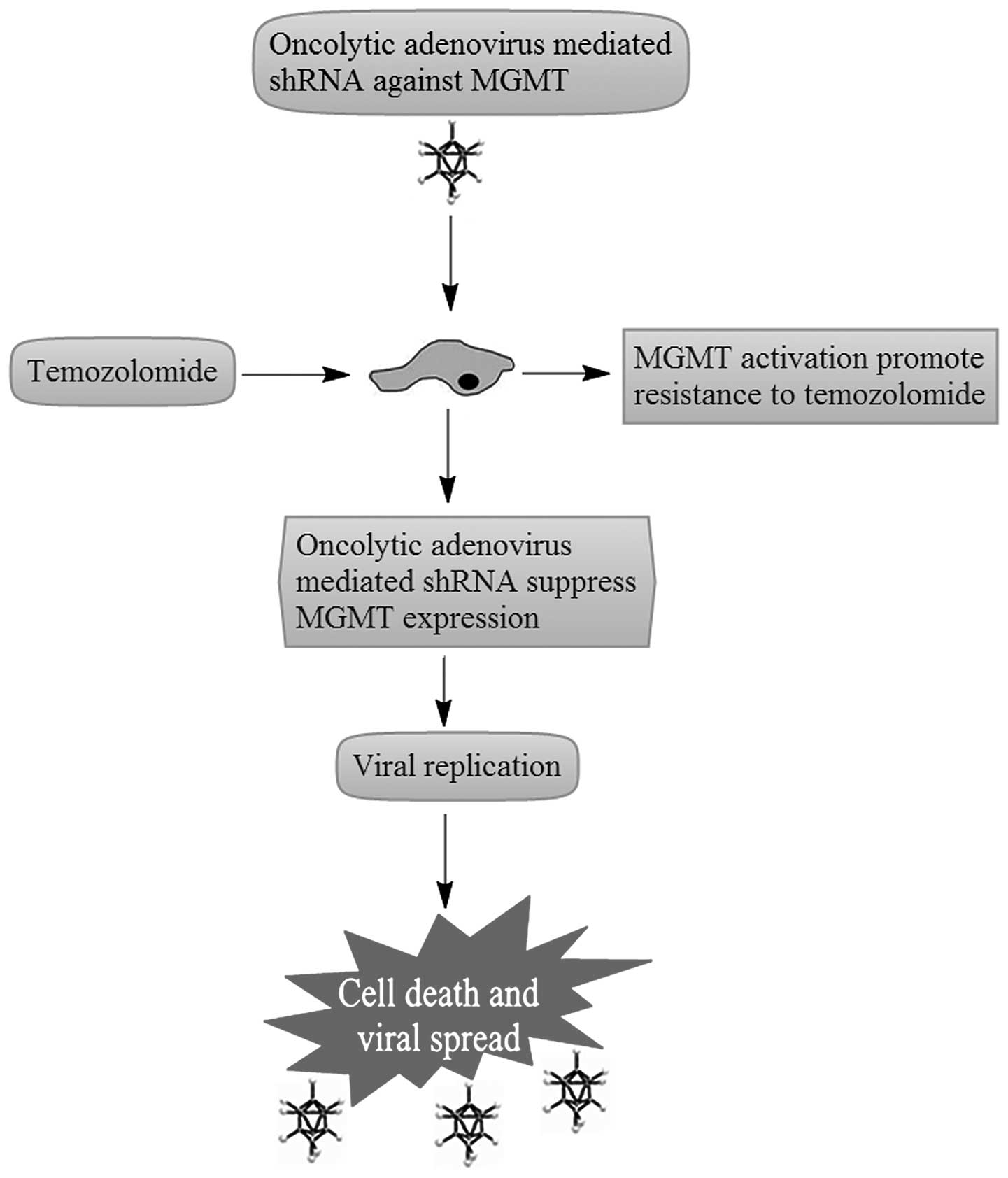Oncolytic adenovirus-expressed RNA interference of O6‑methylguanine DNA methyltransferase activity may enhance the antitumor effects of temozolomide
- Authors:
- Published online on: August 12, 2014 https://doi.org/10.3892/ol.2014.2442
- Pages: 2201-2202
Abstract
Perspective
As a relatively recently identified alkylating (methylating) agent, temozolomide (TMZ) has become a focus of attention, most notably in malignant glioma and melanoma treatment (1,2). Resistance to TMZ occurs following prolonged treatment and therefore poses a major therapeutic challenge. A key mechanism of the resistance to TMZ is the overexpression of O6-methylguanine-DNA methyl transferase (MGMT) (3). MGMT repairs the TMZ-induced DNA lesion, O6MeG, by removing the methyl group from guanine to a cysteine residue (4). Suppressing MGMT activity, therefore, could enhance the cytotoxicity of TMZ against melanoma and glioblastoma multiforme (4).
In previous years, we have focused our research on oncolytic virotherapy. Oncolytic viruses exhibit selective replication and lysis in tumor cells, while also amplifying the expression and functions of therapeutic gene in the tumor microenvironment (5). Two main strategies are used for oncolytic adenovirus generation. One strategy is the deletion of the viral element that is required for replication of the virus in normal cells, but is dispensable in tumor cells, such as ONYX-015 or ZD55 with E1B-55K gene deletion (6,7). The other strategy is the use of a tumor-specific promoter to drive the gene that is required for viral replication (8). In clinical trials, the E1B 55-kDa-deleted oncolytic virus, ONYX-015, or the ONYX-015 derivative, H101, have exhibited encouraging anticancer activity when combined with chemotherapy (9).
RNA interference (RNAi) technology is able to downregulate targeted genes and has been evaluated as a potential therapeutic strategy in human cancer therapy (10). The knockdown of DNA repair genes by small interfering RNA (siRNA) and virally delivered short hairpin RNA (shRNA), can sensitize various cancer cells to chemotherapeutic agents in vitro (11). A previous study has shown that the use of siRNA to transiently transfect nasopharyngeal carcinoma cells and glioma cells results in the inhibition of MGMT gene expression and increased sensitivity to bis-chloroethylnitrosourea (12). Similarly, a study by Kato et al (13) revealed that the transduction of TMZ-resistant glioma cells with a LipoTrust™ liposome, which contains siRNA to inhibit MGMT gene expression, enhanced the sensitivity of the glioma cells to TMZ.
Zheng et al (14,15) focused on the production of several shRNA constructs using an oncolytic virus for delivery. Examples of these constructs included siRNAs against Ki67 and hTERT, which were observed to act as antiproliferative and apoptotic inducers in cancer cells. shRNA delivery via armed oncolytic viruses has potential for enhancing antitumor efficacy as a consequence of synergism between viral replication and oncolysis and shRNA antitumor responses (11). When conveying shRNA, oncolytic viruses are expected to effect a marked reduction in the tumor MGMT level, which should result in an increase in the cytotoxicity of TMZ (Fig. 1).
We hypothesize that the effects of the oncolytic virus-mediated RNAi of MGMT activity may enhance the cytotoxicity of TMZ in tumors for the following reasons: Firstly, the use of armed oncolytic viruses to deliver shRNA combines the advantages of gene therapy and virotherapy. The inserted shRNA can target the DNA repair protein, MGMT, in tumor cells and multiply by several 100- to several 1,000-fold in parallel with viral replication. The oncolytic adenovirus-armed shRNA targeting MGMT also offers the advantage of enhancing shRNA-mediated antitumor responses through its intrinsic oncolytic activity (10). Secondly, as a delivery agent that couples shRNA expression with viral replication, oncolytic adenoviruses can minimize the effects of off-target activity in normal cells, and facilitate, sustain and regenerate shRNA expression within the tumor microenvironment (15). Thirdly, as oncolytic adenovirus vectors and chemotherapeutic agents act by different mechanisms, there is a synergistic or additive effect rather than cross-resistance on the death of tumor cells (5).
The combination of these advantages and possibilities suggest that using oncolytic adenoviruses to deliver therapeutic shRNA targeting MGMT protein may be a powerful technique for overcoming resistance to TMZ in human cancers. This may result in a significantly enhanced antitumor outcome through MGMT-knockdown and viral oncolysis.
Acknowledgements
This study was supported by a grant from the National Natural Science Foundation of China (grant no. 81372916).










